Undeservedly forgotten. Brief history of the gun PS-3, based on the documents
***
HISTORY PS-3 began with the adoption in 1927 of the decision to create a domestic maneuverable tank. On November 17, the technical task for the 12-ton maneuverable tank of the first version was approved, which received the T-1-12 index. The armament of the tank, stipulated in the TZ, was envisaged in the form of an 45-mm "OAT system of a semi-automatic tank gun GUVP arr. 1925 g. ", Or" 60-mm high-power howitzers. "
Despite the fact that the 45-mm cannon sample already existed “in the metal” and even made several test shots, it had to be practically redesigned anew. However, the caliber 45-mm for maneuverable (medium) tank was already considered less preferable. Therefore, the greatest attention was paid to the 60-mm gun, which was created by P.S. Syachintov in the summer of 1929. The order letter stated that the “new high-power tank gun” should be designed “in the manner of the French Gunchiss gun”.
Pyotr Syachintov was one of the competent engineers who received a good education and therefore could deal not only with the layout of new tools, but also calculated the internal and external ballistics of tools, designed projectiles. However, the designer could not immediately take up the much-needed army order. By that time, the 76-mm gun for the TG tank (which received the A-19 index, or AC-19) and the 37-mm high-power gun for T-19 / T-20 and TG tanks (PS-1BM / PS-2) .. Only in the spring of 1930 the designer presented the Artkom commission a draft 60-mm gun, proposing to change its caliber to 57-mm or 76,2-mm, which in his opinion would simplify the situation with ammunition and manufacturing a rifled barrel pipe, and also add to the implement a semiautomatic mechanism. The admissions committee seemed to agree with the designer’s arguments and ordered to prepare a set of drawings for the 7-mm “high-power tank semi-automatic howitzer” on 57-mm for November, keeping the design scheme proposed by P. Syacintov.
In the autumn, the final design of the gun was approved and in January 1931 its drawings were transferred to the artillery plant at Podlipki for the manufacture of a prototype. But before the summer, the work on the manufacture of the gun was not started, and in September 1931, the order was canceled for some unknown reason.
But in December 1931, interest in the gun resumed, and now the designer was given the task of creating the “76-mm semi-automatic tank gun”, and not the “howitzer”, as it was called before. This order was signed by M. Tukhachevsky in February 1932. The prototype gun had to make the first shot on November 1 1932, and on November 7 1932, he already had to go to the parade in the turret of the T-35 heavy tank. However, the plans, but tested on the field carriage, gun No. 1 suddenly refused to work normally (cases of incomplete closing of the gate wedge during intensive shooting and insufficiently vigorous ejection of the sleeve, which drastically slowed the process of loading the gun), and under the curtain, being installed in the T-tower 35, and completely out of order. Therefore, the tank that set off for the parade received a “technological” PS-3 layout, which was distinguished by the absence of a rifled barrel pipe.
At the end of 1932, PS-3 No. 2 was refined and subjected to tests by shooting from the bollard. According to the report of the test site No. 1Н / 268 from 11 in March 1933, 1079 shots were fired from the bollard, during which all the mechanisms of the gun worked normally.
From 17 to 21 in March, the PS-3 cannon No. 4 was installed in the T-35 tank turret, which was mounted on a specially constructed log house. Under the base of the tower, a steel sheet 8 mm thick was fastened, on which a ring gear with ball bearings for horizontal laying was riveted. The frame was additionally fastened with iron brackets and bolts with plates to ensure the necessary rigidity. A total of 465 shots were made from this installation, after which the turret was installed on the T-35 tank, then the T-28, where it was tested before 1934. According to the report of the test site No. 1Н / 828 from 23.10.1934, the tank fired from the spot, from the course and from short stops, making a total of 1005 shots, after which an “improved cylindrical shape” tower was installed on it.
During the modifications of the artillery system, P.Syachintov proposed to improve the design of many tower mechanisms. Here is a brief description of the new tower design given in one of the comments on the field test report:
"The device hoist the following:
... the toothed sector, which is attached to the left side of the system's bassinet, toothed gear, worm wheel, worm and roller with a flywheel. All the details of the mechanism are in a bronze box, which is attached to the inner wall of the tower, with bolts and nuts.
The force on the handle of the lifting mechanism with the highest angle of elevation is 2,5 kg, with the largest angle of reduction 0,3 kg, which can be considered normal.
The pivot mechanism is as follows:
Gear wheel (shoulder strap) gear and roller with flywheel, and just like the under-gear mechanism, all parts are located in a bronze box ... It must be added that the turning mechanism has a good gear box, with which you can easily change the pointing speed horizontally ... Now there are two horizontal speeds, as well as a neutral position. Switching speeds is carried out by moving the handle with a stopper located on the right side of the box of the turning mechanism ...
The force on the handle when turning at the highest speed 12-13 kg. Convenience pickup can be improved by adding a motor turning the tower, which offers the designer - Comrade. Syachents (here it is Syachents - through “e”, MS) ...
The turret also has a new periscope-type sight, which is located on the left side of the gun, mounted on the ceiling of the turret and connected to the swinging part with the help of hinged levers ...
During the tests, it was found that the maximum possible vertical guidance angle in this type of tower is possible to reach 25 gr 13 min, descent angle -13 gr., But normal shooting is possible only up to the descent angle -3 gr 10 min. Further, the sliding part can be hit when shooting at the tower ceiling ...
Firing tests were carried out with an old-style grenade, reduced to 6,5 kg mass and normal charges for a divisional gun. A total of 250 shots were made at elevation angles from 0 to 25 ° with both medium and high firing rates ...
Test results:
1. When the system was installed, an imbalance of the cannon’s vault was detected (the muzzle portion was outweighed), as a result of which the guidance mechanism was jerky while the cannon was lowered, and at elevation a little difficult.
To eliminate this phenomenon, the plant attached a load to the rear transverse wall of the cylinder-holder weighing approx. 6 kg.
Comparative data pushen after the end of the first test cycle PS-3 | |||
KB | Kirov a-d | e-dim Voroshilov | zd - Red Put and l sheep " |
Index | arr. 1927 / 32 (KG) | rev.1933g. (PS-3) | - |
Projectile weight, kg | 6,5 | 6,5 | 6,5 |
Charge weight, kg | 0,475 | 0,935 | 0,9 |
Charging density | 0,3 | 0,55 | 0,53 |
Allowable pressure | 1850 | 2570 | 2350 |
Early speed, m / s | 381 | 520 | 540 |
Barrel length, klb | 16,4 | 20 | 24 |
Weight of sliding parts, kg | 294 | 337 | 420 |
Max rollback length, mm | 500 | 450 | 520 |
Rollback Resistance | 3450 | 7100 | 5300 |
Shutter type | piston | wedge p / a | wedge p / a |
The work of the mechanism improved, but the value of the load was apparently insufficient. It is necessary to increase the weight of this load to 8-8,5 kg, or redo the sleeve catcher from the wall thickness Zmm. on 7-8mm. During the tests, the lifting mechanism functioned perfectly. No damage was found, except for loosening the upper bolts attaching the lifting gear box to the tower wall.
2. No malfunctions were also noted in the pivot mechanism, and a large force on the handle is explained by the fact that the toothed circle (shoulder strap) when fastening the frame with staples was strongly tightened (compressed). That is why it was a great difficulty in work, which was not noted when installing the turret on the tank hull ...
The only comment to the design can be a grabbing of the gunner’s hand on the knee, to eliminate which it is necessary to move the gunner’s seat backwards.
3. When measuring the bore of the gun after 250 shots, an increase in the diameter of the channel is not observed. All dimensions are normal ... Only some chipping of the rifling fields at the beginning of the rifled part is noted.
4. In the work of semi-automatics, the same shortcomings were noted that were indicated in the March 11 report.
The system rate of fire is reached at 15-18 shots. and can be improved by correcting defects in semi-automation.
Damage to the semiautomatic system is not detected.
5. Work recoil mechanisms is beautiful. Rollback within 420-423 mm. Non-dokaty absent, reel - smooth, without knocking.
Conclusion
It is necessary to recognize:
1) lifting mechanism - survived, but you need to balance the trunk.
2) turning mechanism - once again test with a gun in the tank. It is possible that when the tank rolls his work will be difficult. Work out the proposal of Comrade. Syaintov on the installation of an electric motor to drive a turn ... "
It is interesting to note that prior to the completion of these tests, the decision on accepting the PS-3 into service was still hanging in the balance, because then two more competitors were considered to arm the T-28 and T-35: “tank gun mod. 1932, the Kirov Plant, as well as the “high-power semi-automatic tank gun” of the Krasny Putilovets plant. But competitors lost the battle at that moment, as the ak gun of the Kirov factory (“KT” - Kirov tank) showed the worst results, and the gun of the factory “Red Putilovets” was not made on time.
An interesting feature of the PS-3 cannon was its ability to absorb shots of not only regimental guns arr. 1927, but also regular shots of the divisional gun arr. 1902 g., Even with a charge of gunpowder in 935 g., While the KT gun could only use the "regiment" shots arr. 1927 with the 475 gunpowder charge. Another important advantage of the PS-3 was a semi-automatic wedge gate, which ensured normal loading of the gun from the place and in the movement of the tank by one person, while in the KT gun it was all very, very difficult.
Be that as it may, but, despite some shortcomings in the work of semi-automatics, in May 1933, the PS-3 cannon was put into service under the symbol “tank gun mod. 1933, ”and the Kirov Plant was tasked with mastering its mass production. The gun of the same KT (made on the basis of the design of the regimental cannon sample 1927) was allowed for armament of the T-35 and T-28 tanks "until the beginning of the mass production of the 76,2-mm special tank gun of the PS-3 type", since they were almost the same.
Also interesting is the phrase noted in the report on 76-mm tank guns 1934. “The universal tank gun of the type“ L ”is technically imperfect, it has a lot of flaws. The development of the “L” type cannon be stopped immediately. ”Once again I want to emphasize that the PS-3 was precisely a SPECIAL TANK cannon, since it had its original ballistics and was specially adapted specifically and only for installation in a tank.
Despite the fact that the PS-3 gun has already been put into service, work on its fine-tuning has been actively continued. Initially, they were led by the designer himself, but with the start of mass production and the appointment of P.Syachintov as the head of the “special vehicles and self-propelled” section of the Motorization and Mechanization Department, all work on the PS-3 was transferred from OKMO to the Kirovsky Design Bureau.
The latest changes in the PS-3 design, carried out under the guidance of P. Syachintov, were:
1. New spindle brake spindle introduced, two rods instead of three.
2. Added a run-up moderator of the type used in the PS-1, PS-1BM and PS-2 guns.
3. Knurled cylinders are extended to accommodate longer springs.
4. The semiautomatic system has been modified with an additional closing spring for reliable semi-auto operation on shots with a small charge (regimental gun).
And then began the mass production weekdays. The guns were produced, tested on various models of tanks and self-propelled guns, and returned to the factory, since despite the normal operation of the prototypes and reference samples, the serial PS-3, released from the factory gates, refused to work normally.
The plant produced and reworked batch after batch with changes aimed at eliminating the next identified deficiencies, but the process went in a circle.
Already 26 November 1933. The PS-3 gun was installed in the turret of the T-26-4 tank, having a frame from T-28, by means of an adaptation. The tests were conducted mainly for durability and revealed a small perished roof armor plates, while firing. But after strengthening the structure of the tower, the tests were completed successfully. All in all, the X-NUMX PS-26 cannons were installed in the T-4-2 turrets, but due to the cessation of the release of the T-3-26 tanks, further experiments were aimed at installing the PS-4 into turretless ACS.
In 1935, the AT-1 ACS, armed with the PS-3 gun No. 11, was put to the test. On tests, good results were achieved. For example, the longest firing range was practically 10580 m, while the task was to be 7500-8000 m. The ACS was recommended for use, but by May 1936 none of the 5 machines ordered for military tests and guns for them They were not delivered to the customer.
In the mass production of guns, the plant constantly ran into “bottlenecks.” Associated with a lack of equipment and trained personnel. Without touching the mechanisms of semi-automatics, progressive cutting and a roll brake of a variable profile were especially difficult. No wonder that the plant by hook or by crook tried to simplify the design of the gun. For example, according to the report No. 1Н / 853 from 2.12.35 g, to simplify the construction of the PS-3, they have changed the cutting of the bore. For example, the gun number 59, filed for these tests, already had a constant cutting slope and a slightly longer barrel, which for some reason was still thin-walled, like the first samples. Moreover, since the plant did not ship a single standard cannon to the customer, the customer refused to provide the No. 59 T-28 tank for testing the guns. Therefore, shooting tests were conducted not from a tower installation, but from a wheeled farm-carriage (as in the document). The tests ended unsuccessfully and soon the NKV commission was sent to the plant, designed to deal with the state of things, but the factory design bureaux in every way hampered the commission’s work, actively proposing its product, the universal L-3 gun, which at the end of 10 in return for PS-1936. was adopted by the spacecraft.
Briefly, the history of the revolving around PS-3 is well covered in the June 14 8 Magazine of the Artcom Committee (JACKS), dedicated to the completion of the first stage of comparative testing of L-1938, L-7 and PS-10 guns, as well as in the letter of the SORKIN engineer, 3 and name of the People's Commissar of Defense on the state of affairs on the new 3-mm tank guns of high power. Here are some excerpts from this letter:
In 1933, the PS-3 cannon was redone, the design flaws were eliminated, and a decision was made to manufacture a series of these cannons at 1934 ... The Kirov factory received an order for the 125 cannons ...
But the order was stopped because In the guns were found defects and ... flaws, although all the costs for their elimination by the designers of the plant were paid for by the Arthur Office ...
From 1934, numerous changes were introduced in PS-3 (option C, option M, etc.) Almost all units and components affected the changes. The contract with the plant went from year to year 1935 - 125 pcs, 1936 - 90 pcs, 1937 - 90 pcs, but the plant regularly broke down, and the deficiencies were not eliminated ...
In 1935, a special group was appointed by GVMUAU order No. 044 / 093 from 10.Х.35 to revise the PS-3 factory drawings, which contained a large number of deviations from the drawings of the reference instrument ...
According to the specified finalized drawings from 11.XI. 1936 plant manufactured only 6 guns №№ 1,5,23,43,4 and 59; of these, No. 4 and 59 had old trunks with thin tubes; 4 trunk had a progressive cutting, and 59 - constant in 20 klb. Both systems had reworked detractors with run up moderators and a new semi-automatics.
Systems No. 1, 23 and 43 had new trunks with a thick pipe and an equal position of the ledge by the amount of output of the pipe from the casing. The cutting is the normal number of 1 and 23 (20 klb), and the number 43 is 30 klb ... The anti-skidders differed in the abbreviated length of rollback 390-420 mm. Semiautomatic - new.
The system number 5 had an elongated barrel on the 210 mm - a monoblock with a screwed breech and a shortened cradle armor. The barrel number 23 was installed on the AT-1 passed with him the whole cycle of ground tests ...
The guns Nos. 4 and 59 were repeatedly tested at the NIAP and gave satisfactory results, but nevertheless it was not possible to achieve completely uninterrupted operation of the automation. Until this system was eliminated, it was impossible to allow for troop tests ...
According to the results of testing the guns on the AT-1, satisfaction was noted. the work of the gun, but in a number of parameters (for example: the location of the ammunition, not the comfortable position of the rotary mechanism, etc.) AT-1 for military tests did not allow ...
According to the drawings of the gun number 23, which was completely satisfied with the reliability of operation, the Kirov plant was supposed to release the 90 pieces of the improved PS-3 guns, but did not release any and raised the question of switching to their own L-10 gun ... "
This document is interesting because it was compiled at the time when P. Syachintsov was already repressed on charges of sabotage, but Sorkin did not give a single abusive statement addressed to him and did not push the marked shortcomings of the weapon at him.
And by the close of a couple more interesting excerpts from various documents relating to the topic under consideration and that time:
Reason: Order 16.10.36 spacecraft armament on the organization of a commission for spacecraft tank guns
PS-3 - special tank gun caliber 76-mm, 1,75 times the power of the 76-mm regimental gun, arr. 1927 g. And tank arr. 1927 / 32 It can use all types of three-inch ammunition gun 1900 and 1902g arr ..., while the system arr. 1927 / 32 and L-10 require only shots of the regimental cannon arr, 1927 g ...
It is preferable to arm a medium and heavy tank system with a barrel length 20 caliber with thick walls and progressive cutting, but they are more difficult to manufacture than the option with constant cutting and thin-walled barrel with a casing ...
The work of the commission convincingly shows that the PS-3 system is quite modern and designed in good faith ...
All the flaws of the guns are related to the fact that the samples examined had large deviations from the approved drawings ... "
TTX serial PS-3 release 1935, | |
|---|---|
| Barrel length full mm / klb | 1640/21,5 |
| Threaded length mm | 1076 |
| Number of rifling | 24 |
| Angle vert. guidance, hail | -8.5 / + 22,5 |
| Barrel weight, kg | 330 |
| Weight of swinging bowl, kg | 615 |
| Weight of sliding parts, kg | 355 |
| Shutter weight, kg | 17,5 |
| Normal recoil length, mm | 420 |
| Max, rollback length, mm | 460 |
| Early velocity, projectile, m / s | 520 |
| Early new projectile speed, m / s | 530 |
| Early projectile speed 6 / 6, m / s | 505 |
| Direct shot range, m | 489 |
| Firing range, m. (в turret T-28 with 23 angle) | 8760 |
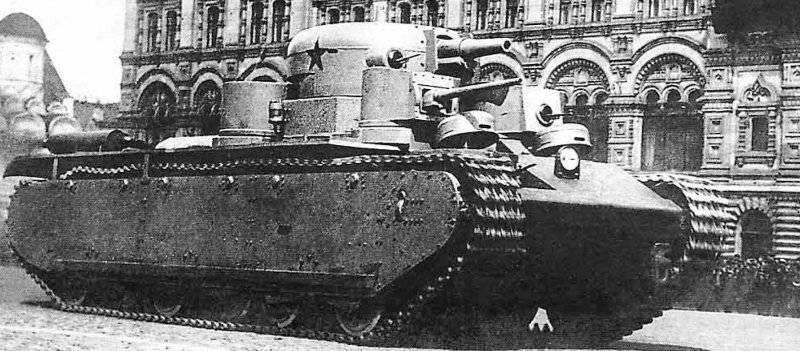
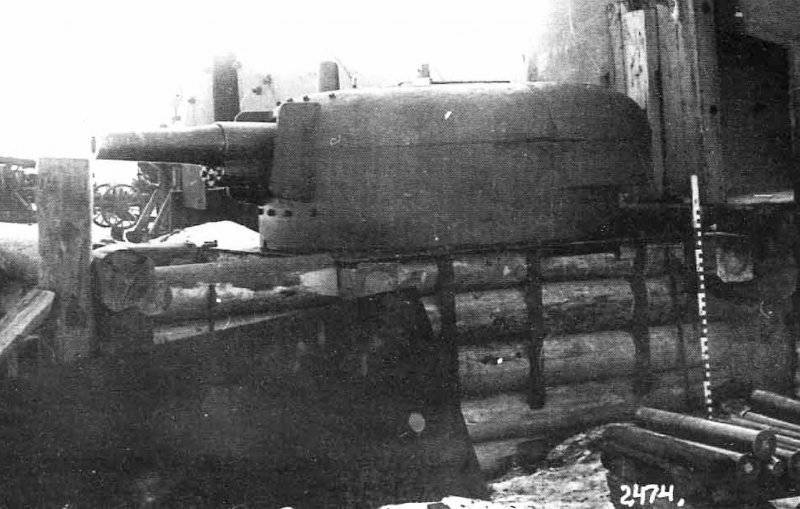
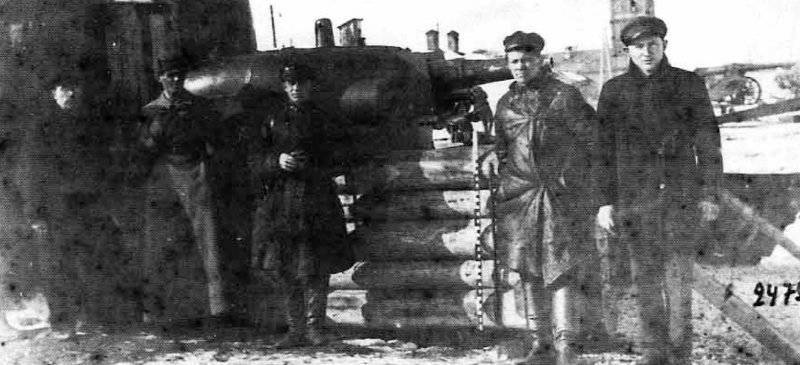
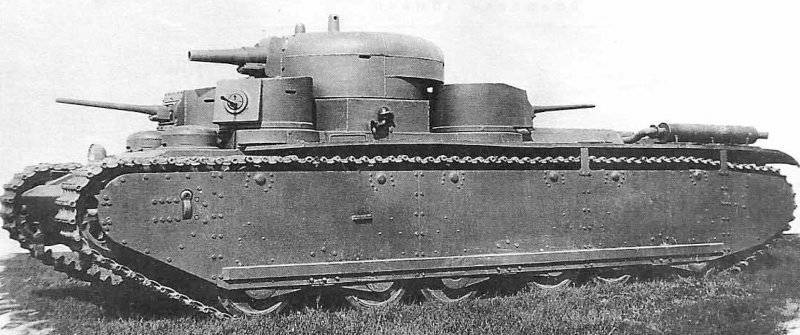
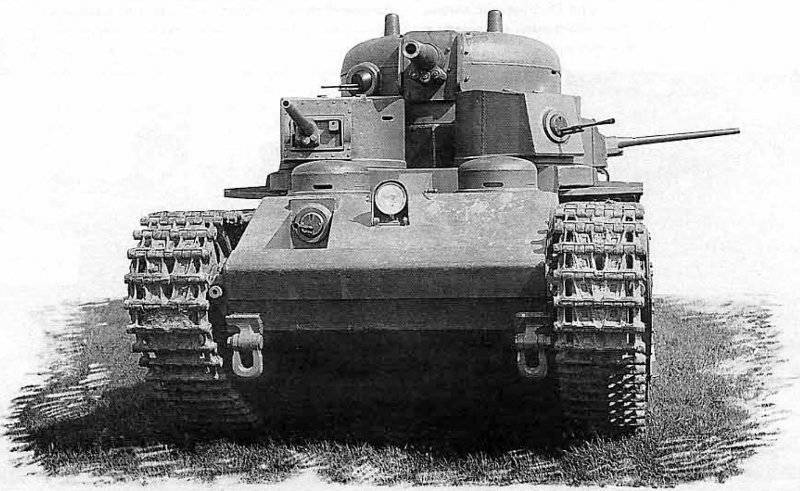

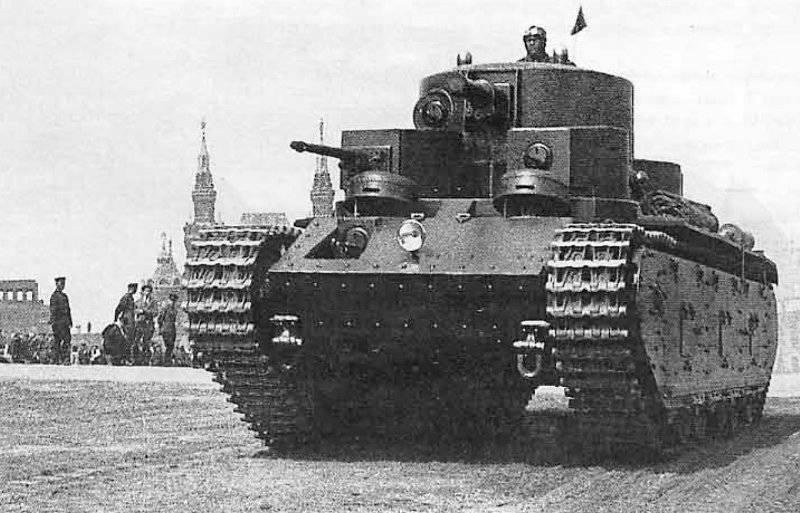
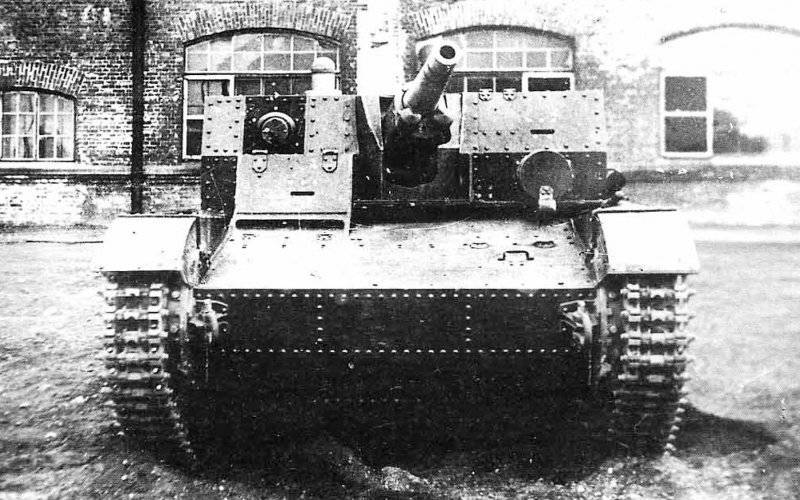
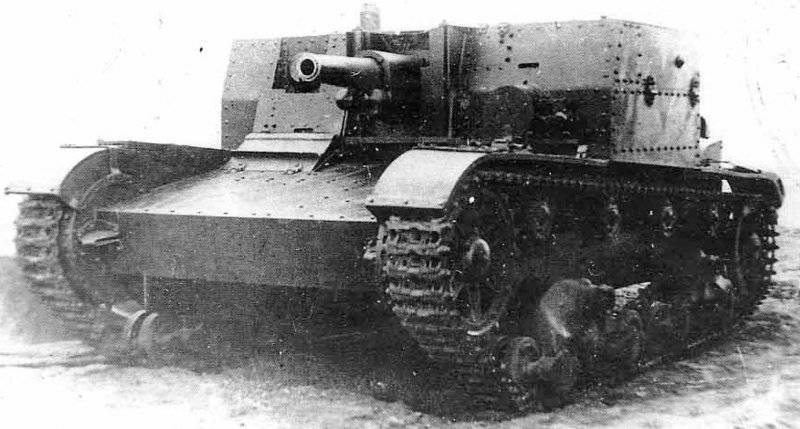
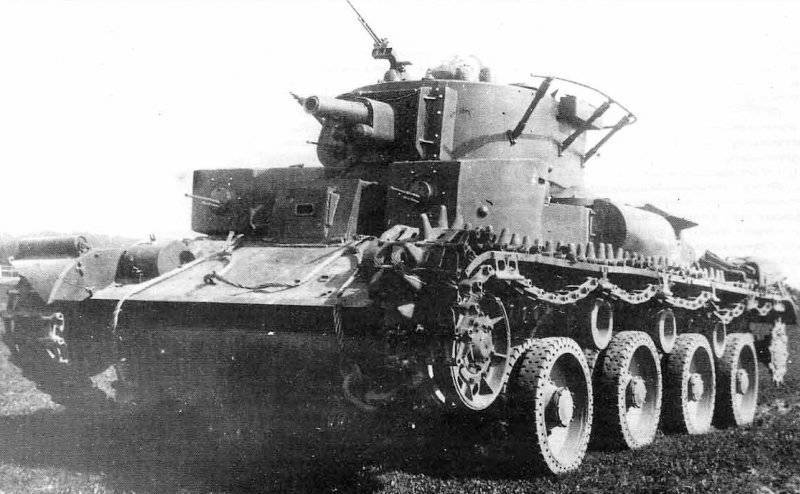
Information